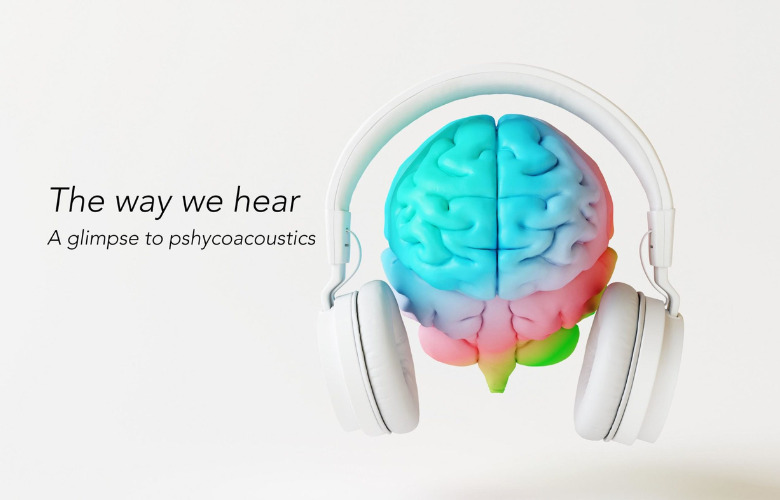
Lately, all these concepts have been gaining popularity in the sound field, many manufacturers have started to increase their innovations for the audience to experience even more realistic immersive sound. But what’s the theory behind it?
Immersive sound, 3D sound, and Surround sound are all referring to the same thing and it is basically how sound can be manipulated to recreate real-life sound on speakers and headphones, making it closer to a 360 experience. These manipulations are based purely on how our brain tricks us to hear things, It is all related to the way we hear.
The way our brain processes the information we receive in our ears defines the way we hear. Meaning that additionally to the physical shapes of our body and the mechanical characteristics of the sound waves, it is actually the brain, combining this information, creates the perception of sound. There have been studies about it and the theory behind those studies is called Psychoacoustics.
Starting with the human body, there have been several studies that defined very accurately the physical structure of our ear and the role they play in the process of hearing:
The external ear, where sound waves hit the eardrum and make it vibrate
The medium ear where the small bones transfer these vibrations from the eardrum to the internal ear (malleus, incus, and stapes)
The internal ear where these vibrations reach the Cochlea, in which interior millions of hair cells vibrate and produce signals sent to the brain
Once the brain receives these signals, it processes them according to its properties
Here is where psychoacoustics plays a role and explains with different phenomena how we can perceive sound depending on different properties of the sound and the way our brain is programmed. There are many concepts and explanations about how our brain behaves when listening to sound:
Physically each region of the Cochlea acts as an amplifier to mechano-electrical transduction that gives “hair cells” an electromotility property which gives selectivity and sensitivity to the frequencies we hear by areas.
One common disease related to this is tinnitus, at least 20% of the population is affected by it, where despite the existence of an external sound, the person can hear phantom noises due to age-related hearing loss, an ear injury or a problem with the circulatory system
This phenomenon happens when a signal containing all harmonic elements but the fundamental is detected by the brain who identifies the pattern of the signal and tricks us to hear that fundamental frequency that is not present.
The Ear has a specific response to what we hear, meaning the higher the Sound Pressure Level (SPL) is, the flatter the response is in our ears, i.e., we tend to hear frequency range more evenly with a higher SPL. If the SPL is lower, lower frequencies are more present in our hearing
For each tonal frequency, there is an associated masking threshold with a critical bandwidth, where any signal reproduced inside this bandwidth and below that threshold will not be heard. For frequencies around 20Hz and 400Hz, this bandwidth varies between 100Hz<BW <400Hz, behaving logarithmically on the raise. Meaning our brain processes most information within the lower frequencies, a concept utilized in audio compression such as mp3 to removed frequencies masked on the higher frequencies range
There have been findings showing that even if over 26KHz frequencies cannot be heard, they can be detected as brain activity in MRI images, causing different responses in individuals such as pleasure, tranquility, and dynamic appreciations
It has been determined that the way our brain deciphers the position of a sound is determined by high frequencies. Because the wavelength at high frequencies is comparable to the dimensions of our body, it can let the brain understand what the position of the sound source is in reference to our bodies. However, lower frequencies can also help to determine the sound source by measuring phase differences between signals perceived by each ear.
When two sound sources with the same distance and SPL to the hearing person (stereo) will produce a ghost image in the middle of the sources. If one of the sources is attenuated or delayed (5ms or -18dB), the ghost image will move from the center closer to one of the sources. Here is where concepts like time difference and level differences between audio signals are the key for most professional audio applications
The Head Related and Head Phones Transfer Functions are mathematical equations that explain how our head, torso, and ear shapes affect the way we hear, meaning how the distance between our ears, dimensions, curves, shapes, bones reflections, and bones resonators affect each frequency of a sound wave defining the sound perception for each specific individual. These anthropometric measurements are used to define personalized HRTF and HPTF.
As mentioned before, all these concepts are being applied in Professional sound applications based on psychoacoustics theory:
Oohashi, Tsutomu (1991). High-Frequency sound above the audible range affects brain electric activity and sound perception. AES 91st Convention. NY
Sunder, K., Tan E., Gan W. (2014) Effect of headphone equalization on auditory distances perception. AES 137th Convention LA.
Novatech & Adelaide Symphony Orchestra Present Harry Potter and the Prisoner of Azkaban in L-ISA. https://www.youtube.com/watch?v=3VMfMA1i-hY
What is AMBEO Immersive Audio by Sennheiser? https://www.youtube.com/watch?v=uIpVM4-3tV4
Binaural Audio Recording. https://www.youtube.com/watch?v=vGt9DjCnnt0
ASMR 3D Tingles | Zoom H3 VR Mic Test (No Talking). https://www.youtube.com/watch?v=Hrf87AdR3Eg
Woo Lee, G., Kook Kim, H. (2018) Personalized HRTF Modeling Based on Deep Neural Network Using Anthropometric Measurements and Images of the Ear


The mission of SoundGirls.org is to inspire and empower the next generation of women in audio. Our mission is to create a supportive community for women in audio and music production, providing the tools, knowledge, and support to further their careers. SoundGirls.Org was formed in 2013 by veteran live sound engineers Karrie Keyes and Michelle Sabolchick Pettinato and operates under the Fiscal Sponsorship of The California Women’s Music Festival, a 501(c)3 non-profit organization. In 2012, Karrie and Michelle participated in the “Women of Professional Concert Sound” panel at the AES Conference in San Francisco. The panel was hosted by the Women’s Audio Mission (WAM) and moderated by WAM founder Terri Winston. Terri brought together five women working in live and broadcast audio. The groundbreaking panel (which also included Jeri Palumbo, Claudia Engelhart and Deanne Franklin), provided young women and men a glimpse into life on the road, tips and advice, and a Q & A with the panelists. More importantly though, was how incredibly powerful the experience was for the panelists. We had all been in the business for 20 years or more, yet most of us had never met before that day and within minutes we bonded like long-lost sisters. We were struck by how similar our experiences, work ethics, and passions were and wondered why our paths had never crossed and how our careers would have been different had we been there to support each other through the years. Each of us are strong on our own, but together we were even stronger and a powerful force. We were empowered. Each of us had been asked hundreds of times in our careers: Are there other women doing sound? How did you get into sound? How would a young woman go about getting into sound? Through creating SoundGirls.Org, we hope to establish a place for women working in professional audio to come for support and advice, to share our success and failures, our joys and frustrations, and for empowerment and inspiration.
Read Full Profile© 2021 TheatreArtLife. All rights reserved.

Thank you so much for reading, but you have now reached your free article limit for this month.
Our contributors are currently writing more articles for you to enjoy.
To keep reading, all you have to do is become a subscriber and then you can read unlimited articles anytime.
Your investment will help us continue to ignite connections across the globe in live entertainment and build this community for industry professionals.